Infections almost tripled from 50,694 on May 22 to 154,760 cases and 2975 deaths as of 17 June. This has brought an unusual stress on the country’s fragile public health infrastructure, triggering alarm it may collapse altogether if the cases continue to mount at the current speed.
Opposition to the partial lockdown since mid-March, as well as outcry from businesses and industries, prompted Pakistan’s Supreme Court to lift restrictions on shopping malls, arguing the infection was not as widespread as it was in other countries and that there was ‘no pandemic’.
‘There are other serious ailments prevailing in the country, from which people are dying daily… people will die of hunger even if they survive COVID-19 if business activities are not resumed in the country’, remarked Chief Justice Gulzar Ahmed on 18 May.
Politically, the Court provided a double bailout to Prime Minister Khan, who initially opposed a Level 4 lockdown because he initially thought it was a ‘normal flu’ and was worried about its impact on people who depend on daily work for their livelihood — like vendors, kiosk owners and construction workers.
‘We face the twin challenge of balancing the need to prevent proliferation of the virus with the urgency to protect 150 million families from starvation’, Khan told the virtual COVID Action Plan, organised by the World Economic Forum, on 20 May.
Before the Court order, which many censured as an intervention in the function of the Executive, Khan’s Pakistan Tehreek-e-Insaf (PTI) party was also locked in a dispute over COVID-19 policy with the southern province of Sindh. The province is currently ruled by the PTI’s archrival the Pakistan People’s Party (PPP).
Complications arose because of ambiguity in the division of powers laid out in the constitution between the centre and the provinces. At the root of this ambiguity was, according to critics of the current system, a dated governance model that suits civilian and military elites more than the people at large.
The COVID-19 pandemic has also exposed the inherent weaknesses of Pakistan’s public healthcare system. It is deficiently equipped with little emphasis on quality of service — for example, Pakistan possesses less than 1000 ventilators for a staggering 220 million people.
Through the US$900 million Ehsaas Emergency Cash Program, the government is making a one-off payment of PRs 12,000 (around US$73) to some 78 million people. Even the budget, presented on 12 June, set aside PRs 208 billion (US$1.26 billion) for the most vulnerable sections of the society, saving the livelihoods of those already living below the poverty line — estimated to be over 55 million out of a population of 220 million.
But the Prime Minister’s political opponents remain critical of his government’s response and have equated Khan’s efforts with indecision. They have accused him of opening the floodgates to the pandemic — according to some projections, COVID-19 may affect several hundred thousand people by the end of June.
Although the National Command Operations Center (NCOC), which coordinates national efforts against COVID-19, comprises both civilians and military officials, critics allege that Khan has outsourced the fight against coronavirus to the military. While the NCOC is led by Minister for Planning Asad Omar, two generals — including Mohammad Afzal, who also heads the National Disaster Management Authority — are actually calling the shots.
The appointment of the retired general Asim Bajwa, who heads the China–Pakistan Economic Corridor (CPEC) Authority, as a special assistant on information to the Prime Minister is also indicative of the military establishment’s omnipresent influence. Prior to his appointment to lead CPEC he served as Corps Commander in Balochistan, where China is engaged in a number of industrial and communications construction projects. It is thus no surprise that China has dispatched several planeloads of medical gear to help Pakistan combat the coronavirus. It has also sent teams of several hundred doctors and paramedics to help strategise the country’s anti-COVID-19 operations.
As the ruling and opposition parties lock horns over anti-COVID-19 strategies, Pakistan’s complex socio-political dynamics — where big family gatherings are a norm, healthcare is fragile and the economy already reeling under a decades-old system geared towards benefitting a handful civil-military elites — means the country still faces tough fighting ahead against the virus.
Farooq Yousaf holds a PhD in Politics from the University of Newcastle, Australia.
Imtiaz Gul is Executive Director at the Center for Research and Security Studies, Islamabad.
This article is part of an EAF special feature series on the novel coronavirus crisis and its impact.

